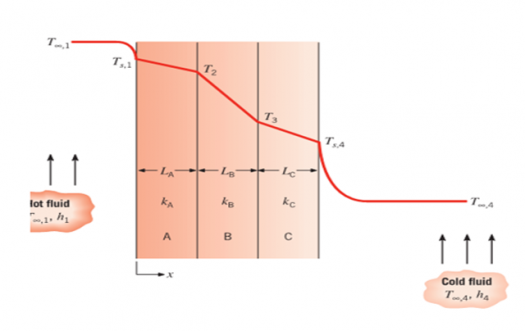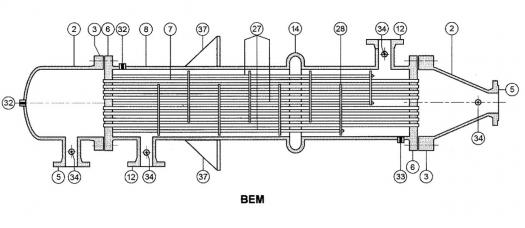Heat Exchanger Basics Quiz

This quiz covers fundamental aspects of heat exchangers, focusing on thermal conductivity, TEMA types, design pressures, and heat transfer modes, suitable for engineering students.
- 1.
Btu/ft-F-hr is the unit of ?
- A.
Conductivity
- B.
Heat Transfer
- C.
Thermal Conductivity
- D.
Thermal Resistance
- E.
None of the above
Correct Answer
C. Thermal ConductivityExplanation
Btu/ft-F-hr is a unit commonly used to measure thermal conductivity, which is the property of a material to conduct heat. This unit represents the amount of heat that is conducted through a one-foot thickness of material with a temperature difference of one degree Fahrenheit per hour. Therefore, the correct answer is Thermal Conductivity.Rate this question:
-
- 2.
Which TEMA Type is this ?
- A.
N F T
- B.
N J P
- C.
B F T
- D.
None of the above
Correct Answer
A. N F TExplanation
The given TEMA Type is NFT.Rate this question:
-
- 3.
Which type of end is used in case of tube side design pressure greater than 2100 psig ?
- A.
Front End Type N
- B.
Front End Type D
- C.
Rear End Type T
- D.
Rear End Type S
Correct Answer
B. Front End Type DExplanation
In case of tube side design pressure greater than 2100 psig, Front End Type D is used.Rate this question:
-
- 4.
Thermal design of a heat exchanger is not get affected by:
- A.
Front End
- B.
Pass Partition
- C.
Rear End
- D.
Baffle
Correct Answer
A. Front EndExplanation
The thermal design of a heat exchanger is not affected by the front end. The front end refers to the entrance section of the heat exchanger where the fluid enters. The design of the front end typically focuses on ensuring proper flow distribution and minimizing pressure drop. However, it does not directly impact the heat transfer efficiency or the overall thermal performance of the heat exchanger. The factors that primarily affect the thermal design include the pass partition, rear end, and baffles, as they play a crucial role in enhancing heat transfer by promoting turbulence and increasing the contact surface area between the fluids.Rate this question:
-
- 5.
What are the modes of Heat Transfer ?
- A.
All mentioned below
- B.
Radiation
- C.
Conduction
- D.
Convection
- E.
None of these
Correct Answer
A. All mentioned belowExplanation
The modes of heat transfer include radiation, conduction, and convection. Radiation is the transfer of heat through electromagnetic waves, while conduction is the transfer of heat through direct contact between objects. Convection is the transfer of heat through the movement of fluids or gases. Therefore, the correct answer is "All mentioned below" as all three modes of heat transfer are listed.Rate this question:
-
- 6.
The resultant Heat Transfer co-efficient for the below heat transfer system is: (Note: Consider all parameters shown in below figure as a unity)
- A.
3
- B.
1/3
- C.
5
- D.
1/5
- E.
None of these
Correct Answer
D. 1/5Explanation
The correct answer is 1/5. In heat transfer systems, the heat transfer coefficient represents the ability of a material to transfer heat from one side to another. A higher heat transfer coefficient indicates better heat transfer. In this case, the answer is 1/5, which means that the system has a relatively low heat transfer coefficient. This suggests that the material in the system is not very efficient at transferring heat, and may result in slower or less effective heat transfer.Rate this question:
-
- 7.
We called the Item 27 in the following figure as-
- A.
Tubes
- B.
Tie Rods
- C.
Baffle
- D.
Pass partition plate
Correct Answer
B. Tie Rods -
- 8.
Which of the following is not true about U-tube heat exchanger ?
- A.
The tube bundle is removable
- B.
Low construction cost
- C.
Requires larger tube diameter than in other exchangers
- D.
One pass is possible.
Correct Answer
D. One pass is possible.Explanation
The U-tube heat exchanger is a type of heat exchanger where the tube bundle is removable and it has a low construction cost. Additionally, it requires a larger tube diameter compared to other exchangers. However, one pass is not possible in a U-tube heat exchanger.Rate this question:
-
- 9.
Which of the following is a one pass shell :
- A.
G- Shell
- B.
F- Shell
- C.
E- Shell
- D.
H- Shell
Correct Answer
C. E- ShellExplanation
The one pass shell refers to a shell that executes commands in a single pass, without the need for multiple iterations or passes. In this context, the correct answer is E- Shell, as it is the only option provided that fits this description.Rate this question:
-
- 10.
On Heat exchanger mechanical datasheet tubes are defined by:
- A.
Tube OD
- B.
Tube Material
- C.
Tube wall thickness
- D.
Both option 1 and 3
- E.
All the three options
Correct Answer
E. All the three optionsExplanation
On a heat exchanger mechanical datasheet, tubes are defined by their outer diameter (OD), the material they are made of, and their wall thickness. Therefore, all three options (1, 2, and 3) are correct as they each represent a different characteristic of the tubes.Rate this question:
-
- 11.
Kettle shell type is used for ________ services.
Correct Answer
vaporizingExplanation
The kettle shell type is used for vaporizing services. This means that the design and structure of the kettle shell is specifically suited for the process of vaporizing substances. The shape and materials used in the kettle shell allow for efficient heat transfer and containment of the vaporized substance, making it ideal for this particular service.Rate this question:
- 12.
Minimum baffle spacing as per TEMA is :
- A.
Equal to Shell ID
- B.
4 inches
- C.
1/5 x Shell ID
- D.
Minimum of (1/5 x Shell ID) and 4 inches
Correct Answer
D. Minimum of (1/5 x Shell ID) and 4 inchesExplanation
The correct answer is the minimum of (1/5 x Shell ID) and 4 inches. According to TEMA (Tubular Exchanger Manufacturers Association) standards, the minimum baffle spacing should be determined by taking either 1/5 of the Shell ID or 4 inches, whichever is greater. This ensures proper flow distribution and heat transfer within the heat exchanger.Rate this question:
-
- 13.
Type of tube patterns are -
- A.
Triangular (30 deg)
- B.
Square
- C.
Rotated Triangular (60 deg)
- D.
Rotated Square (45 deg)
- E.
All first three options
- F.
All of the above
Correct Answer
F. All of the aboveExplanation
The given question is asking about the type of tube patterns. The options provided are triangular (30 deg), square, rotated triangular (60 deg), rotated square (45 deg), all first three options, and all of the above. The correct answer is "All of the above" because it includes all the mentioned types of tube patterns, which are triangular (30 deg), square, rotated triangular (60 deg), and rotated square (45 deg).Rate this question:
-
- 14.
Tubeside velocity can be increased by using -
- A.
Pass partition plates
- B.
Baffles
- C.
More tubes
- D.
N type front end
Correct Answer
A. Pass partition platesExplanation
Pass partition plates can increase tubeside velocity because they create additional flow paths for the fluid to pass through. By dividing the fluid into smaller streams, the velocity of each stream increases, resulting in an overall increase in tubeside velocity. This can be beneficial in applications where higher velocity is desired for improved heat transfer or fluid mixing.Rate this question:
-
- 15.
Baffle cut varies in between ________ % to ________ % of shell ID.
Correct Answer
15
45Explanation
The baffle cut refers to the percentage of the shell's inner diameter that is occupied by the baffles. In this case, the baffle cut can vary between 15% to 45% of the shell's inner diameter. This means that the baffles will occupy a portion of the shell's interior ranging from 15% to 45% of its total diameter.Rate this question:
Quiz Review Timeline +
Our quizzes are rigorously reviewed, monitored and continuously updated by our expert board to maintain accuracy, relevance, and timeliness.
-
Current Version
-
Mar 15, 2023Quiz Edited by
ProProfs Editorial Team -
May 17, 2020Quiz Created by
Shreekrushna Jarag
 Back to top
Back to top





